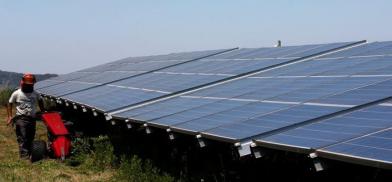Ultra-mega solar parks kickstart India's clean energy transition
Renewable energy in India has taken centrestage with significant development of energy infrastructure and attracted foreign capital to achieve the economic goals, as ultra-mega solar parks kick-start the country's clean energy transition

Renewable energy in India has taken centrestage with significant development of energy infrastructure and attracted foreign capital to achieve the economic goals, as ultra-mega solar parks kick-start the country's clean energy transition.
With an aim to transform the country's polluting fossil fuel-based power sector into a renewable energy-based, low-cost, reliable and low-emission system, the country has set an impressive target of installing 175 GW of renewable energy by 2021-22 and 275 GW by 2026-27.
"To achieve this, India has pioneered the ultra-mega solar parks and, in the process, overcame a range of challenging obstacles. Indian utility-scale solar parks have kick-started India's energy sector transition," said Kashish Shah, a researcher analyst at US-based Institute for Energy Economics and Financial Analysis.
The country's approach towards building ultra-mega power plants attracts global capital from some of the most renowned domestic and international renewable energy developers. This gives investors an opportunity to join a USD 500-700 billion renewable energy and grid infrastructure investment boom in the coming decade.
The ultra-mega power plant concept involves a state government or local distribution company facilitating a single central grid connection and taking on the procurement and time delay risks relating to land acquisition.
"This approach has been instrumental in driving economies of scale and attracting global capital into India's renewable energy over the last five years, with an immediate boon in the form of a halving of solar tariffs to a record low of Rs 2.44 per kilowatt-hour achieved in mid-2017," said Shah.
The analyst said that the country now houses multiple ultra-mega solar parks with a capacity of more than 1 GW, and two of them are the largest commissioned in the world to date. "As of March 2020, India's on-grid renewable energy capacity stood at 87 GW," he added.
Amid myriad policy and project execution issues, the country's utility-scale solar park model has firmly stood its ground, the researcher opined, adding that over a period of time, they have successfully overcome risks such as project execution risk, off-taker risk and operation and maintenance risk.
He said that Rajasthan's Bhadla solar park is the world's largest solar installation till date with 2,245 MW capacity and covers over 14,000 acres of area.
Bhadla project has attracted record low solar tariffs in the range of Rs 2.44-Rs 2.62 kilowatt-hour, which remain among the lowest tariffs in the country till date.
"India should rightly take pride in being able to execute world-leading renewable energy projects. It is worth looking back over the last four years to see just how far the Indian renewable energy industry has advanced," said Shah.
Besides, under-construction Ananthapuramu Solar Park in Andhra Pradesh will be the largest solar power facility to be built from domestically manufactured solar cells and modules, aligning with the Indian government's 'Make in India' programme.
Additionally, alluding to the recent nine-minutes 'lights off' event, Shah asserted that since grid successfully managed reduction and consequent increase in demand during the period and therefore with the right planning and investment, the country's robust national electricity grid could be further developed to handle large-scale renewable integration.
India's power industry and the government should make good use of the coronavirus lockdown period to resolve long-pending problems and to be fully prepared for a green infrastructure investment stimulus as India comes out of this pandemic, Shah remarked.









Post a Comment